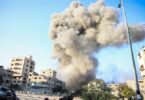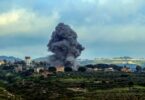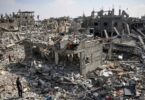SHIROKOV Andrey
120 days ago, Israel was exactly in the middle of another military air campaign in the Gaza Strip, aimed at suppressing massive rocket attacks on the territory of the Jewish state by radicals from the Palestinian enclave. It lasted 11 days – from 10 to 21 May, after which the ceasefire between Israel and Palestinian groups in the sector came into force. According to official data, 257 residents of the coastal enclave became victims of the confrontation, about 2 thousand were injured. On the Israeli side, 13 people were killed.
Since then, with the active mediation of Egypt, work has been going on on a permanent armistice agreement between the parties to the conflict. But it is already flaring up with renewed vigor.
Another escalation in a typical scenario
The first missile, after a three-month hiatus, was fired from Gaza into Israel in mid-August, then the radicals resumed launching balloons with attached combustible substances and explosives to set fire to Israeli territory. The Israeli Air Force responded by regularly hitting Hamas military targets in the Gaza Strip. On September 10, 11 and 12, every evening the Iron Dome air defense system intercepted a missile fired from Gaza at the city of Sderot in the south of the Jewish state, then fighters hit the targets of radicals in the sector at night. On September 12, after air strikes, another missile was fired and intercepted. Machine-gun fire was opened on Israel from the Gaza Strip.
“The same video is playing again, as if on replay. It seems that there is simply no solution to the problem of the Gaza Strip,” the Jerusalem Post stated this week .The publication notes that an Israeli army officer who wished to remain anonymous recently made it clear that there are “only two options for success” in relation to Gaza, and both of them are unlikely. The first is “the overthrow of the radical Hamas movement in Gaza and the re-occupation of the Gaza Strip” by Israel. The second envisages the overthrow of Hamas and the transformation of the Palestinian enclave into Dubai 2.0. Since it is difficult to implement a change of power in the sector, as is shown by the experience of several large military operations in the enclave since 2007, when Hamas came to power in Gaza, it is proposed as a “best temporary option” to simply come to terms with the situation, waiting for sharp exacerbations and rounds of missile strikes similar to those that took place in May, the newspaper said.
Foreign Minister’s initiative: the third way
“The State of Israel needs to answer the question: what do we want to do with Gaza? suffering to our people and damaging our economy, ”Lapid said at a September 12 security conference. According to the minister, in order to solve the problem with radicals from the Palestinian enclave, Israel “needs to start a long-term process under the slogan” Economy in exchange for security. “
To be honest, this has happened before, and not only with regard to Iraq with oil in exchange for food. Even Lapid himself admitted this, noting that his proposed program is “a more realistic version of what in the past was called” rehabilitation in exchange for demilitarization “for the Gaza Strip. never before was introduced in an official form as part of a comprehensive concept for the consideration of the Palestinian problem, “Lapid said in this regard, pointing out that” the goal of the whole process is to create stability on both sides of the border. “And naturally,” the international community and the people of Gaza should know that Hamas terrorism is what stands between them and normal life, “the Israeli Foreign Minister added,
Two-step plan
Lapid said that the “initial plan” for solving the problem of the Gaza Strip in the development of the Foreign Ministry experts consists of two stages. The first includes “large-scale humanitarian rehabilitation of the Gaza Strip in exchange for coordinated efforts against the military build-up of Hamas.” In particular, “the electricity supply system will be repaired, gas will be connected, a desalination plan will be built, there will be significant improvements in the health care system, and housing and transport infrastructure will be reconstructed” in the Gaza Strip. Hamas is only required to “maintain long-term calm” while “the international community will use its influence over Hamas.” The minister explained that “
Lapid summed up the essence of the first part of the process as follows: “The security formula at the first stage is simple – in exchange for silence, we are ready to give more than before, but if peace is disturbed, Hamas and other terrorist organizations should know that the response will be tougher than earlier … If the first stage is determined as successful, we will be able to move on to the second stage, which is precisely called “Economy in exchange for security”.
The second stage, the same
The Economy for Security program will become the second stage of Lapid’s plan, “will be developed and presented in full” and then “will show what the future of Gaza can be if Hamas accepts the principles of the Middle East Quartet (UN, EU, Russia and the USA ) “, the minister promised. “In these conditions, the economy of Gaza will completely change, life in Gaza will look fundamentally different,” he added.
Lapid provided many interesting details of the second phase, which have also surfaced as separate proposals in recent years. In particular, he mentioned the project of an artificial island off the coast of Gaza, which will allow the construction of a port there, as well as the creation of a transport highway between the sector and the West Bank of the Jordan River. The idea of creating a port on the island was first announced about ten years ago, and the transport branch was one of the points of a very detailed roadmap (and an equally unsuccessful peace plan) 20 years ago.
It should be noted that Lapid clearly understands what he is doing and what he is saying. “The solution that I propose today is not ideal. It is important for me to present a different concept of moving forward before we face the prospect of another escalation,” he explained, speaking at the conference. In addition, Lapid noted that “the presented decision does not concern the settlement of the conflict on the basis of the two-state principle,” but considers it right to strengthen the positions of the Palestinian National Authority so that in the future it would be possible to conduct serious negotiations with it. “The political conditions in both Israel and the Palestinian Authority at the moment do not allow for diplomatic progress, but in Gaza we can and must act now,” he concluded.
A lot of work and little chance
“There is still work to be done, we are still in the development stage, but if this plan has a chance of success and receives broad support, I will propose it to the government as an official position and we will get down to work,” Lapid said. presenting their program at a security conference. “There will be experts who will tell you that this plan has no chance. The answer is: we never tried. For too long, we had only two options: the conquest of Gaza or endless rounds of violence.”
Lapid pointed out that “from the point of view of Israel, the representatives of the Palestinians are not Hamas, but the Palestinian National Authority.” “I’ll make it clear right away that it’s not about a proposal to negotiate with Hamas. Israel doesn’t talk with terrorist organizations that want to destroy us,” he explained.
“It’s time to put pressure on Hamas. It’s time to force the Gazans to put pressure on Hamas, because they understand what they are losing as a result of terrorism, and understand how much they will get if this terrorism stops,” the minister added, separately admitting that for implementation his programs will take years, not months.
Another dead end at the end of the tunnel?
The search for a solution to the Gaza Strip seems to be running into the same dead end at the very beginning of the tunnel leading to the light. Lapid calls for the overthrow of Hamas, and then start pumping investments in the Gaza Strip, which, in his opinion, will lead to prosperity. Previously, this did not work, but, indeed, it has not yet been proposed so frankly.
In the meantime, it seems that the time has come for the cautious to renew the supply of drinking water in the bomb shelter.
Courtesy: (TASS)






